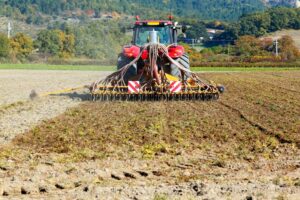Crop rotation plays a crucial role in soil fertility and plant nutrition. Agricultural soil testing plays a crucial role in analyzing multiple parameters like chemical content, toxicity, pH level, salinity, earth-dwelling biota, and more. Soil testing also offers information on chemical contamination, organic content, electric conductivity, cation exchange capacity, and other chemical and physical properties. All of these are highly critical in determining the fertility of the soil and plant nutrition.
Soil organic matter and clay particles hold a large store of plant nutrients. These reservoirs are not available to the crop. In organic crop rotation, the grower can manage soil organic matter and nutrient availability by incorporating different crop residues, cycling among the crops that have different needs, using cover crops, and additional soil amendments. Most of the crops deplete soil nutrients in their growth cycle. Some of these nutrients leave the farm as harvested products, while the rest return to the soil as crop residues.
Therefore, the nutrients in residues might not be available to the next crop. Crop roots and residues improve soil fertility by stimulating the soil microbial communities. This improves soil aggregation. The improved physical environment facilitates water holding, water infiltration, aeration, enhancing root growth, and plant nutrient foraging.
Effective Benefits of Crop Rotation on Soil Health & Plant Productivity:
One of the most important benefits of crop rotation is that it helps in improving soil health by increasing the diversity of the plants in a field. Agricultural soil testing shows that when a crop is grown in a field for years, it depletes the soil of specific nutrients, and it leads to the build-up of different pests and diseases. By rotating crops, the farmers can maintain a healthy balance of nutrients in the soil, reducing the risk of disease outbreaks and pests.

Crop rotation helps in reducing the need for chemical inputs like pesticides and fertilizers. Agricultural soil test shows the nutrient content of the soil. When different crops are grown in a field, they can help naturally enrich the soil. Thus, it reduces the need for chemical inputs. This is highly beneficial for organic farmers who have to rely on the natural methods of pest and disease control.
Along with improving soil health, crop rotation can also improve crop productivity. Different types of crops have different nutrient requirements. Rotating crops can help in ensuring that the soil has the required nutrients needed for optimal growth. This leads to higher crop yields and makes farming much more profitable.
Crop rotation is also beneficial for the environment. By rotating the crops, farmers can help in reducing soil erosion. The risk of soil degradation is also reduced significantly. Along with that, rotating crops increase the number of beneficial insects in a field. This can help in controlling pests and reduce the requirement of chemical pesticides.
Another crucial aspect of crop rotation is it helps in diversifying the farm’s income streams. By rotating the crops, farmers can take advantage of different market conditions, and they can potentially earn more by growing a wider variety of crops. This is highly beneficial for small-scale farmers who depend on farming as their primary source of income.
For implementing a successful crop rotation system, farmers must consider specific factors. These include the types of crops that are perfectly suitable for the soil and climate conditions. The length of the growing season, the types of pests, and diseases that are present in the area. Also, it is crucial to opt for agricultural soil testing. This will help the farmers to plan ahead and have a better understanding of the crop rotation schedule that they will follow.
How to Rotate Crops?
The first step to rotating crops is careful planning. It is better to create a uniform section within the land. The plots can be divided to accommodate shorter plans to cater to different production needs. Make sure not to grow the same or closely related plants in close succession. Therefore, it is crucial to separate them according to the family of crops. Categorizing the plants according to their physical characteristics, management needs, growth patterns, and harvest times might be more practical. Adjustments to a short-rotation system like switching to a different plant or introducing green manures must be done whenever possible.
Crop rotation can be done in the following ways:
Rotate by family – This is the most common technique for crop rotation. This process involves planting different plant families on a field in a seasonal and sequential fashion.
Rotation by plant compatibility – It is crucial to consider which plants complement one another while planning a rotation cycle. For instance, sweet corn is highly recommended as a pre-potato plant because of its positive impact on potato productivity.
Rotate according to nutrient requirements – This approach includes planting legumes first and followed by heavy feeders like tomatoes or corn in the following year.
Crop rotation by depth & type – This technique needs crops to be altered between the growing plants with deep and shallow roots, like beets and cauliflower, in a single plot.
Including legumes and cover plants – A grass or tiny grain planted during the fall will use the unused nitrogen. Even though the legumes are not as good as grasses at reusing nitrogen, they enrich the soil that the next plant can benefit.
In Conclusion:
Crop rotation plays a crucial role in improving soil health, increasing productivity, and reducing the need for chemical inputs. If farmers continue to opt for periodic agricultural soil tests and keep on rotating crops, they can benefit from higher crop yields, ensure a more diverse income stream, and ensure a healthier environment for the crops. By planning carefully and implementing a crop rotation system, farmers can ensure the long-term success of their farming operations.
To learn more about building a successful farm management plan, including soil analysis programs, contact the experts at SoilOptix online or at info@soiloptix.com.
